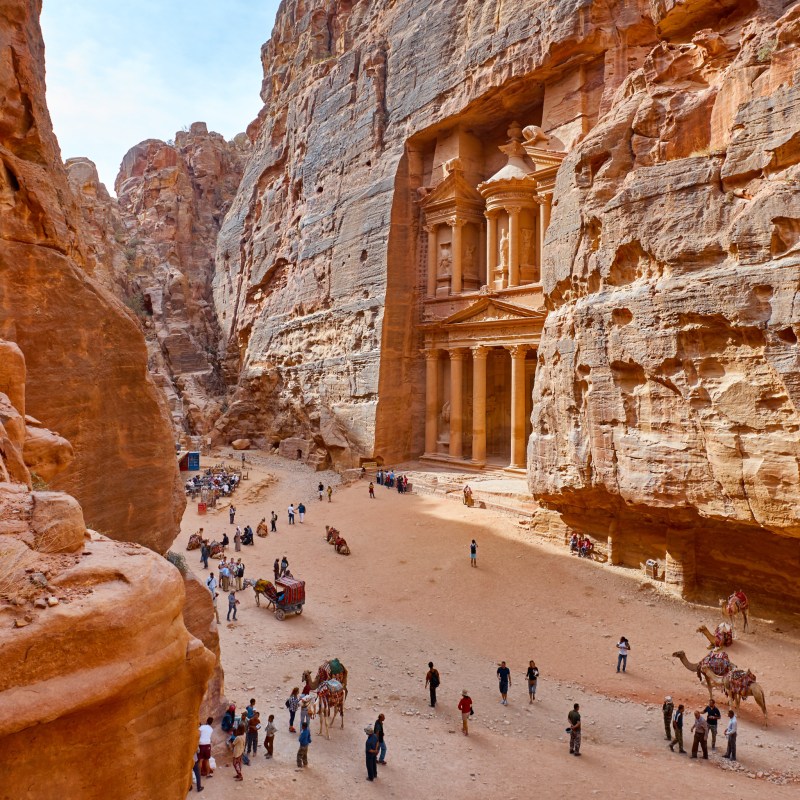
Visiting Petra, Jordan, in the rain isn’t most people’s choice — and it wasn’t really my choice either — but it had its advantages: no crowds, fewer distracting kiosks selling tchotchkes, and cascading waterfalls and rock colors made more resplendent by the water.
Videos by TravelAwaits
I planned to fly from Athens to London last February, but by the time I priced my ticket, costs had soared to $350 one way. I jumped at a $76 fare that included a 21-hour layover in Aqaba, Jordan. I’d been to Jordan five times to report from Iraq during the early days of the United States-led occupation and to report from Jordan’s refugee camps, but I’d never toured Petra. The generous layover was my chance to finally explore the 2,300-year-old city carved into rose-colored sandstone mountains that, because of its location midway between Damascus, Syria, and the Red Sea, had been an important layover for traders.
Here are a few things I wish I’d known before visiting.

1. January And February Are The Rainy Months
It didn’t just rain during my one-night layover — it snowed! Fortunately, I’d brought my winter coat and hiking boots to Greece, so I was prepared for the cold, but I wouldn’t ordinarily think of the Middle East as a place freezing enough to show my breath!
The best months to visit to avoid the scorching summer and the rainy winter are March, April, and May and September, October, and November.
2. Buy A Jordan Pass
The Jordan Pass costs only 70 Jordanian dinars for a single-day visit to Petra, and it includes free entrance to 40 other tourist sites and a tourist visa (which normally costs 40 Jordanian dinars for a single entry). Without the pass, single-day tickets to Petra cost 50 Jordanian dinars (about $71).
The Jordan Pass can only be purchased online and must be purchased before your trip.
However, the Jordan Pass might not make sense if you enter through the southern port city of Aqaba, where visa costs are waived if you stay at least 48 hours. If you leave within 48 hours, you’ll be charged the visa cost upon departure.

3. Take The ‘Back Door’
Apparently, there are two “back doors,” or back entrances, to Petra that the Bedouins use. The biggest benefit of entering from the back is that you avoid climbing uphill all day as you hike from the main entrance to the Great Temple, which is at the far end of the accessible part of the archaeological site. It’s also a good way to avoid the cruise-ship crunch of tourists who usually stop midway at the Treasury.
The entrance I never found feeds into the top of the Monastery, one of the key sites (and climbs) of Petra. The “back door” I entered was about a half-hour walk from the Bedouin Camp, and it took me another hour to reach the Great Temple. It was tough to find on my own; I asked for directions several times.
Contrary to what you might read elsewhere on the internet, you can enter through the back door without a guide, but you will need a ticket.
4. Bring Your Own Food And Water
You pay for location! The Crowne Plaza, located at the foot of the trail to the Monastery, has a restaurant that offers a buffet lunch for 17 Jordanian dinars, or a whopping $24. Water, tea, and snacks are readily available throughout the archaeological sites at Bedouin kiosks — but expect to pay a premium. To save money, bring your own food and water.

5. Consider Hiring A Guide
All the advice I received was to not hire a guide. And certainly it’s not necessary. Each of the sites has an interesting description in English, and free maps are available at each entrance. But a licensed guide can offer insights into Bedouin culture, reveal secret tombs and not-easily-seen details, take you through shortcuts accessible only if you are guided, and help in an emergency.
It rained so hard the day I toured Petra that the park flooded in areas. I was alone, but thankfully, another tourist’s guide gave me valuable updated information: The park was closing because of the flooding, and I wouldn’t be able to reach the front gate; I’d need to leave through the back entrance from where I came.
By then, it was raining pretty steadily, and I was not relishing an hour’s walk to the nearest accessible exit. Fortunately, a group of tourists (and their guide) offered me a ride in their truck, taking me out of the archaeological site and through the adjacent town to the main entrance, where my taxi driver met me.

6. Don’t Ride Donkeys, Horses, Or Camels
Although it’s tempting to fall for the romance of riding a camel around Petra’s ancient temples, please resist. There are many reports of camels, horses, and donkeys who are beaten with pipes and whips, left in the searing sun with no water, or suffer from festering wounds from too-tight harnesses. While there are undoubtedly responsible animal owners, there are no animal welfare regulations to guarantee these working animals’ protection, according to SPANA, a nonprofit organization that works in communities to provide free veterinary care, education, and animal-friendly harnesses.

7. Stay At A Bedouin Camp Instead Of A Chain Hotel
I stayed at the Little Petra Bedouin Camp in a comfy bed with a private bathroom. The breakfast buffet with omelet station cost only 5 euros ($6). Had I arrived earlier in the evening, I would have been treated to a Bedouin music concert!
Planning an overnight stay near the archaeological site gives you an extra day to explore the temples, tombs, caves, and ingenious water system spread over nearly 300 square miles.
8. Stop For Tea
My friend Rita Golden Gelman, who traveled full time from her 40s into her 70s and wrote Tales of a Female Nomad, has a rule: Take all food and drink that’s offered.
Although I suspected the Bedouins’ constant offers of tea were a sales gimmick meant to stall me long enough for them to show off their wares, I took every steaming glass offered. Especially as I ascended the rugged path to the Monastery in the cold rain, I welcomed the opportunity to warm my freezing hands, catch my breath, dry my wet boots by the fire, and chat a bit. I found that after it became clear I wasn’t interested in their goods, but in them, the Bedouins relaxed and shared a bit about their lives. This was the highlight of my time in Petra!

9. Don’t Hike To The Monastery
Aside from all the tea-drinking opportunities along the way, the Monastery — Petra’s largest monument and a must-see for many tourists — was a huge disappointment for me. Reports vary as to the exact number of “steps” one must climb to get there, but that’s not surprising once you see that the “steps” are a broad range of slippery slopes, broken stairs, gravelly paths, and sheer rocks spread over the 656 feet to the top. My wet hike also included mid-calf forges in fast-running streams.
The Monastery is often compared to the Treasury, the more accessible and best-known monument in Petra. (It was a backdrop for the movie Indiana Jones and the Last Crusade.) If you’re not a big hiker, soak in the Treasury instead and save yourself a sweat-soaking climb that also involves coming down the treacherous path on a 1.6-mile round trip.
During my visit, I reached the Monastery moments before fog enshrouded it.
10. Be Prepared For The Altitude
Petra is perched at about 2,700 feet. Expect to be a bit winded while climbing, a bit more thirsty than usual, and a bit more sensitive to sunburn.
In fact, it was Petra’s altitude that prevented me from stopping during a previous trip to Jordan, since I had been scuba diving in Aqaba. It’s recommended to wait 12 hours after multiple days of diving to climb above 2,000 feet. I was en route to Amman to catch my plane, so Petra had to remain on my bucket list.

11. You Don’t Need To Climb To Enjoy Petra
Many intrepid souls happily clamber up the crumbling steps of the Great Temple (I did!) or trudge up to the Monastery. But Petra is pretty awe-inspiring from the ground, too. The Treasury is more than 130 feet high — quite a marvel when viewed from its base, I imagine. The Siq, the ancient irrigation system, is said to be quite exciting, with a new view around every twist of the deep, narrow gorge. I missed those last two stops, as I was evacuated before I could reach them.
Nevertheless, walking down the Street of Facades and touching the remarkably colorful swirls on the sandstone walls, I imagined Petra in its heyday — from the fourth century B.C. to the fourth century A.D. — when adventurous, dusty, and exhausted traders would saunter down this same street, glad, as I was, to finally reach this desert oasis.
For more to see and do in Jordan, see this page.
